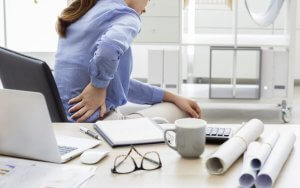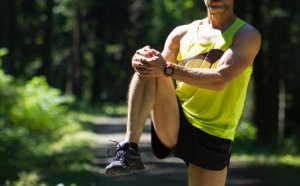Stretches to Ease Lower Back Pain

Back pain is incredibly uncomfortable and affects everyday activities such as working or even resting. Therefore, we have prepared a list with some lower back stretches, with the aim of minimizing the pains in the lower back area.
Certainly, lower back stretches will reduce discomfort. However, like any exercise, lower back stretches don’t provide instant results. However, if you incorporate them into your routine, you will observe the results in a few weeks. Keep reading and we’ll tell you more below.
The best stretches for your lower back
We’ve prepared a list of what we consider to be, the best lumbar stretches. Take note and do not hesitate to practice them if you want to minimize the pain!
1. Knees-to-chest stretch
The first on our list of lumbar stretches consists of bringing the knees to the chest. The procedure for this exercise is really simple. You should start by lying on the floor with your back and feet supported, while your knees should be bent. The hands should be behind the knees.

Next, you must slowly bring both knees to the chest, using your hands to gently pull the knees. Wrap your arms around your thighs, knees or shins, and gently pull on your knee. At this point, we recommend holding the position for 20-30 seconds, before returning to the starting position and repeating the exercise a total of 3 times. In short, it is an ideal stretch to align the pelvis and stretch the lower back.
2. Cobra stretch
The second exercise that you can try is known as the cobra stretch. It’s a useful movement to stretch the abdominal and lumbar muscles. You should start by lying on your stomach with your legs extended and with your palms placed on each side of your head with your forearms and elbows on the floor.
Slowly, push your body up, so that your weight rests on the forearms. Mind you, make sure you keep your hips on the ground. Once you reach a comfortable position, gently stretch the abdominal muscles and the lower back, in addition to maintaining the position for 10 seconds. Slowly return to the starting position and repeat the exercise 5 times.
“No one can rid men of pain, but it will be forgiven to him who gives rebirth in them the courage to endure it.”
-Selma Lagerlof-
3. Child’s pose
Thirdly, we present a typical stretch from yoga classes: child’s pose. To do it, you must start with your hands and knees on the floor, keeping the hands under the shoulders and the knees under the hips. Then lower the body slowly and extend your arms, in addition to placing the palms of your hands on the floor in front of the head.

This position is extremely positive to relieve back pain, besides being very relaxing.
Slowly, your hips should go to your heels, as you lower your head and chest, while you stretch your arms even wider. We recommend using a pillow under your belly to reduce the tension of the muscles of the lower back. You must maintain the position between 20-30 seconds.
4. Tennis ball myofascial release
On the other hand, we present an exercise where you will need a tennis ball to complete it. It’s a stretch that goes to the largest of the gluteal muscles, which is one of the most common trigger points of lower back pain. To begin with, you should lie on your back with both knees bent. Next, place the firm tennis ball under the right gluteus, (directly below the bony point) that is on the lower right side of the spine.
Next, allow your body weight to be on the ball. To increase the stretch, try to extend the left leg and perform small rocking movements on the ball. You must maintain the position for 30-120 seconds, depending on your pain tolerance. Then change sides. If you experience sharp, throbbing pains, stop stretching immediately.
5. Seated twist
Finally, this stretch is ideal to reduce the discomfort that lower back pain brings since it prevents the lower part of the back from contracting. You can do this at home or in the office, or even if you travel in a car since you only need a chair.
To do this, you must hold the left armrest of your seat, and keeping your back straight, turn the right side of your body towards the armrest. Hold this position for 1 minute and step to the other side. If you want to add some difficulty, you can make the turn with the right elbow pointing to the outside of your left leg, and vice versa.
To finish, do not forget that lumbar stretches reduce the discomfort associated with pain. Therefore, we are convinced that thanks to our list of stretches you’ll be able to help reduce your back pain.
Back pain is incredibly uncomfortable and affects everyday activities such as working or even resting. Therefore, we have prepared a list with some lower back stretches, with the aim of minimizing the pains in the lower back area.
Certainly, lower back stretches will reduce discomfort. However, like any exercise, lower back stretches don’t provide instant results. However, if you incorporate them into your routine, you will observe the results in a few weeks. Keep reading and we’ll tell you more below.
The best stretches for your lower back
We’ve prepared a list of what we consider to be, the best lumbar stretches. Take note and do not hesitate to practice them if you want to minimize the pain!
1. Knees-to-chest stretch
The first on our list of lumbar stretches consists of bringing the knees to the chest. The procedure for this exercise is really simple. You should start by lying on the floor with your back and feet supported, while your knees should be bent. The hands should be behind the knees.

Next, you must slowly bring both knees to the chest, using your hands to gently pull the knees. Wrap your arms around your thighs, knees or shins, and gently pull on your knee. At this point, we recommend holding the position for 20-30 seconds, before returning to the starting position and repeating the exercise a total of 3 times. In short, it is an ideal stretch to align the pelvis and stretch the lower back.
2. Cobra stretch
The second exercise that you can try is known as the cobra stretch. It’s a useful movement to stretch the abdominal and lumbar muscles. You should start by lying on your stomach with your legs extended and with your palms placed on each side of your head with your forearms and elbows on the floor.
Slowly, push your body up, so that your weight rests on the forearms. Mind you, make sure you keep your hips on the ground. Once you reach a comfortable position, gently stretch the abdominal muscles and the lower back, in addition to maintaining the position for 10 seconds. Slowly return to the starting position and repeat the exercise 5 times.
“No one can rid men of pain, but it will be forgiven to him who gives rebirth in them the courage to endure it.”
-Selma Lagerlof-
3. Child’s pose
Thirdly, we present a typical stretch from yoga classes: child’s pose. To do it, you must start with your hands and knees on the floor, keeping the hands under the shoulders and the knees under the hips. Then lower the body slowly and extend your arms, in addition to placing the palms of your hands on the floor in front of the head.

This position is extremely positive to relieve back pain, besides being very relaxing.
Slowly, your hips should go to your heels, as you lower your head and chest, while you stretch your arms even wider. We recommend using a pillow under your belly to reduce the tension of the muscles of the lower back. You must maintain the position between 20-30 seconds.
4. Tennis ball myofascial release
On the other hand, we present an exercise where you will need a tennis ball to complete it. It’s a stretch that goes to the largest of the gluteal muscles, which is one of the most common trigger points of lower back pain. To begin with, you should lie on your back with both knees bent. Next, place the firm tennis ball under the right gluteus, (directly below the bony point) that is on the lower right side of the spine.
Next, allow your body weight to be on the ball. To increase the stretch, try to extend the left leg and perform small rocking movements on the ball. You must maintain the position for 30-120 seconds, depending on your pain tolerance. Then change sides. If you experience sharp, throbbing pains, stop stretching immediately.
5. Seated twist
Finally, this stretch is ideal to reduce the discomfort that lower back pain brings since it prevents the lower part of the back from contracting. You can do this at home or in the office, or even if you travel in a car since you only need a chair.
To do this, you must hold the left armrest of your seat, and keeping your back straight, turn the right side of your body towards the armrest. Hold this position for 1 minute and step to the other side. If you want to add some difficulty, you can make the turn with the right elbow pointing to the outside of your left leg, and vice versa.
To finish, do not forget that lumbar stretches reduce the discomfort associated with pain. Therefore, we are convinced that thanks to our list of stretches you’ll be able to help reduce your back pain.
All cited sources were thoroughly reviewed by our team to ensure their quality, reliability, currency, and validity. The bibliography of this article was considered reliable and of academic or scientific accuracy.
- Fernández, N (2014). Dolor lumbar. En contacto: publicación trimestral de novedades y sugerencias para los afiliados de OSMISS, (26). Disponible en: http://www.osmiss.com.ar/news2/wp-content/uploads/2018/05/news26.pdf
- Hernández G, Zamora J (2017). Ejercicio físico como tratamiento en el manejo de lumbalgia. Revista de Salud Pública, 19(1). Disponible en: https://www.scielosp.org/article/rsap/2017.v19n1/123-128/?fbclid=IwAR1F8WK1E0eFMk6dVfNtx3mbE_H-YMJQfSXZoFCv1q1eIe4qYl4_L1bjW5Mamp/
- Lago S, Cuña I (2015). Actualización sobre los efectos de los estiramientos en la lumbalgia: una revisión sistemática. Fisioterapia, 37(6). Disponible en: https://www.sciencedirect.com/science/article/abs/pii/S0211563815000358
- Mayo Clinic. Control del estrés: postura del niño. Disponible en: https://www.mayoclinic.org/es-es/healthy-lifestyle/stress-management/multimedia/childs-pose/
- OSMiSS (2007). Lumbalgia: dolor lumbar. Portal de novedades e información de la Obra social de ministros, secretarios y subsecretarios. Disponible en: https://osmiss.org.ar/news2/2007/09/03/lumbalgia/
- Rathore M, Sinha R, Trivedi S, Siddiqui A (2013). An Anatomical Insight into the Biomechanics of Cobra Posture. International J. of Healthcare & Biomedical Research, 2(1). Disponible en: http://ijhbr.com/pdf/61-66.pdf
- Reyes E (2017). Foam rolling como herramienta de liberación miofascial. Facultad de Ciencias de la Salud, pp.6-9. Disponible en: https://tauja.ujaen.es/handle/10953.1/7753
This text is provided for informational purposes only and does not replace consultation with a professional. If in doubt, consult your specialist.








